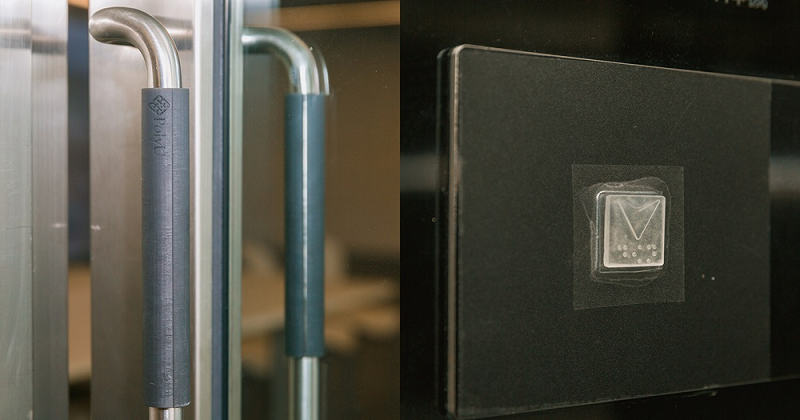While the entire world isn’t locked down anymore, COVID-19 is definitely still here, and still causing plenty of problems. Cases in my area are, thankfully, going down, but (most of) us are still being cautious, just as the HKSAR Government of Hong Kong is telling its citizens to continue keeping personal hygiene at the forefront of their minds during the continuing pandemic. In this vein, an interdisciplinary team of researchers from the Hong Kong Polytechnic University (PolyU) developed a novel anti-virus 3D printing material that they say can kill not only most common bacteria and viruses on surfaces, but also the persistent COVID-19 virus as well.
The material’s main element is resin, and the researchers added anti-viral agents like cationic compounds, which will damage the virus membrane and obliterate its structure, killing bacteria and the virus itself.
“This material is a resin material with high anti-virus performance. Using 3D printing technology, it can be produced in different forms catering to different needs,” said Dr. Kwan Yu Chris Lo, Associate Professor of PolyU’s Institute of Textiles and Clothing, who led the research team. “It is therefore highly flexible and can be used extensively in public facilities to provide epidemic prevention support to the community.”

The research team has produced doorknob covers and lift buttons. As the disinfection components of the material are embedded in the products rather than coated on the surface, daily cleaning with disinfectants such as bleach does not compromise its anti-virus performance.
To say that things like doorknobs, door handles, and buttons in public buildings aren’t really clean is an understatement, and if they’re not sanitized often, bacteria and viruses can grow on these surfaces, which is definitely not ideal for public health. Throughout 2020 and beyond, we saw the 3D printing community step up to lend a hand during COVID, including developing antimicrobial and antiviral materials and novel items like door openers and non-touch badge readers.
This particular research team, supported by the University Research Facility in 3D Printing (U3DP) laboratory, has spent the past year working with the Home Affairs Department, an environmental organization, and the Hong Kong Wetland Park to fabricate public restroom doorknob covers, recycling bin handles, braille boards, elevator buttons, and other items, for the purposes of testing the durability and effectiveness of their novel material in killing the COVID-19 virus.
According to Dr. Lo, their laboratory tests confirmed that this new resin-based material can kill 70% of COVID-19, and other bacteria and viruses, on a surface within two minutes. Additionally, it can get rid of over 90% of viruses within a 10 minute period, and kill nearly all bacteria and viruses on a surface in 20 minutes. Professor Chi-wai Kan, a member of the research team and Professor of PolyU’s Institute of Textiles and Clothing, said daily cleaning of these objects with disinfectants like bleach won’t jeopardize its anti-viral state, because the material’s disinfection components are actually embedded in the products, instead of just coating the surface.
“Even after use for a year, not only is the handle on the recycling bin still in good condition, no COVID-19 virus, Escherichia coli and Staphylococcus aureus are detected on the handle’s surface,” Professor Kan stated. “This proves that the efficacy rate of the material only diminishes gradually after three years of use, and is effective in fighting against viruses and bacteria. Since the material kills viruses via physical means, it can still exert the same effect on mutant viruses.”

An interdisciplinary research team led by Dr. Kwan Yu Chris Lo (middle), Associate Professor of PolyU’s Institute of Textiles and Clothing, has successfully developed an anti-virus 3D printing material.
The PolyU researchers have applied for a patent for their technology and applications, and plan to use it in the future for commercial purposes. The team also hopes to apply the material to healthcare facilities, primary and secondary schools, and public transportation systems. Finally, they will also collaborate with the Sham Shui Po District Office to 3D print protective doorknob covers out of the material for more than 100 unmanaged “Three-Nil” buildings in the district; the covers will be installed on doors used often by residents, in order to lower the risk of virus transmission inside the buildings.
(Source/Images: PolyU)
Subscribe to Our Email Newsletter
Stay up-to-date on all the latest news from the 3D printing industry and receive information and offers from third party vendors.
Print Services
Upload your 3D Models and get them printed quickly and efficiently.
You May Also Like
Heating Up: 3D Systems’ Scott Green Discusses 3D Printing’s Potential in the Data Center Industry
The relentless rise of NVIDIA, the steadily increasing pledges of major private and public investments in national infrastructure projects around the world, and the general cultural obsession with AI have...
3DPOD 260: John Hart on VulcanForms, MIT, Desktop Metal and More
John Hart is a Professor at MIT; he´s also the director of the Laboratory for Manufacturing and Productivity as well as the director of the Center for Advanced Production Technologies....
Etsy Design Rule Change Reduces Selection of 3D Printed Goods
Online marketplace Etsy has implemented a rule change requiring all 3D printed goods on the site to be original designs. The update to the site’s Creativity Standards states, ¨Items produced using...
E-Beam OEM Wayland Additive Partners with USC Racing to 3D Print Titanium Exhaust Collector
Every year, standards organization SAE International holds a competition called Formula SAE, in which students from both undergraduate and graduate programs design, build, and race small formula-style race cars. For...

































